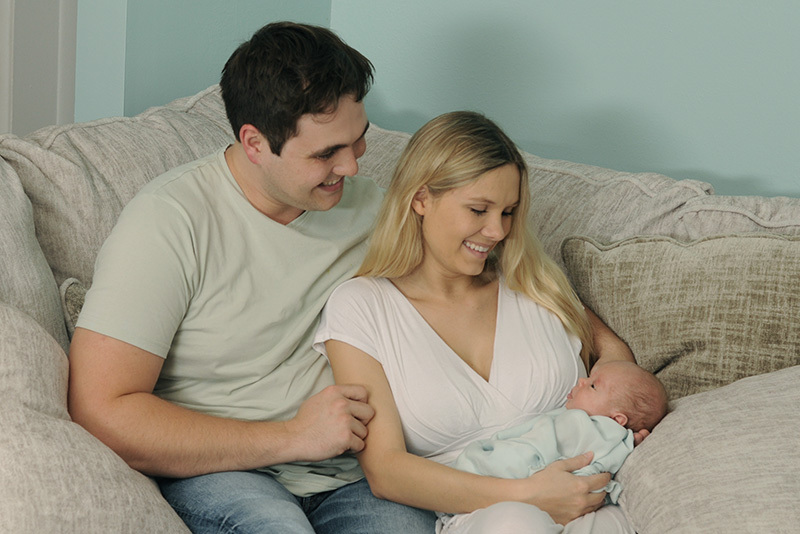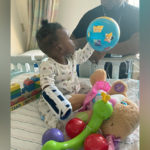Jada’s story: After cloacal exstrophy repair, an unexpected gift

Koda Wilder Ladchuk was born slightly premature, healthy, and happy. But this isn’t just a story about 4-month-old Koda. It’s also a story about his mother, Jada, and an incredible outcome no one could have predicted — not even Jada herself.
Jada, now 25, was born with cloacal exstrophy (also known as OEIS syndrome), a rare condition in which a baby’s bladder and large intestine form on the outside of the abdomen. Babies with cloacal exstrophy also tend to have anomalies in their reproductive and urinary tracts: Jada had two vaginas, two uteruses, and four ovaries, as well as an imperforate anus.
Concerned that the condition was too complex for clinicians at their local hospital in Florida, Jada’s parents decided to travel to Boston Children’s Hospital for her repair. There, Dr. W. Hardy Hendren III, and later, Dr. Joseph Borer, performed a series of surgical procedures to address her various anomalies. “They basically patched me together,” Jada laughs. “My body was kind of a hot mess.”

Independence, adventure — and a big surprise
For Jada, a candid, humorous approach has helped her move through life with ease. One of seven kids, she says her parents encouraged her independence from an early age — and didn’t let anything stand in the way. That led to a passion for travel and adventure, from backpacking around India to scuba diving.
“I never really had issues with self-esteem until I hit puberty,” she remembers. It was then she began to think about fertility and realized she likely wouldn’t be able to conceive. “My whole life, I had been told that I couldn’t get pregnant or deliver a baby,” she says.
So last summer when she and her fiancé, Vlad, discovered that she was pregnant, they were shocked.

Finding care for an unusual pregnancy
The news set off a rush of emotions: surprise, disbelief, excitement, and panic. Jada consulted her friends who were also born with cloacal exstrophy, as well as Dr. Borer. No one had heard of a woman with the condition who had gotten pregnant, let alone had a baby. Although Jada and Vlad were thrilled at the prospect of being parents, they were also worried — especially when Jada had difficulty obtaining timely prenatal care.
“I knew I needed specialized care,” she explains. “But I kept being turned away because most obstetricians didn’t feel comfortable with such a complicated case.” Eventually, she landed at Tampa General Hospital, an academic center “where they viewed my situation as a learning experience, not a liability,” she says.
There, she delivered Koda via a C-section, while other surgeons made sure that the work Dr. Borer had done to reconstruct her urinary and reproductive tracts two decades earlier remained in place. “I’ve never had any problems with the repair,” she says, “and I didn’t want to start then.”

‘Don’t be afraid of the future’
After a long recovery for her — and 16 days in the neonatal intensive care unit for Koda — both mother and baby are doing great. Jada and Vlad would like more children, but they plan to adopt, ideally from Vlad’s home country of Ukraine. “I’m so glad we had this experience, but I don’t really want to put my body through it again,” she laughs.
In the meantime, she wants families of other kids with cloacal exstrophy to know that the condition shouldn’t hold them back. “Even if it doesn’t seem like it now, your child will be able to do whatever they want,” she says. “Don’t be afraid of the future.”
Growing up with cloacal exstrophy: Advice for families
Born with cloacal exstrophy, Jada hasn’t let the condition stop her. Here, she shares her insight for other kids and families:
– Don’t be afraid to be who you are, and don’t let your differences keep you from enjoying life.
– You know your body best. Trust it, and if you think you can do something, go for it.
– Find a mentor. I’ve met lots of other people with cloacal exstrophy through my participation in The Youth Rally camp.
– Set the tone. People will respond to you the way you present yourself. I try to be confident so others see me that way.
– Be open. It may feel uncomfortable at first, but sharing your story helps other kids with cloacal exstrophy know they aren’t alone.
Learn more about the Department of Urology and the Colorectal and Pelvic Malformation Center or make an appointment.
Related Posts :
-

Amazing Grace: Toddler receives life-changing care for cloacal anomaly
Grace Brown loves playing with her six brothers and sisters, watching educational TV shows, and just being an average toddler. ...
-

Answers for Aubree: Finding support for OEIS
Michelle and Stephen Strickland are used to having questions about their infant daughter, Aubree’s, health. After all, Aubree was ...
-

Laparoscopic approach to cloacal malformation repair found safe in eligible patients
A minimally invasive surgical approach called laparoscopic rectal mobilization and urogenital separation appears to be a safe alternative to open ...
-

'Finally in the right place': Peyton’s journey to Boston
When Peyton Miklas comes to Boston Children’s Hospital for an appointment, she isn’t just seeing Dr. Belinda ...





